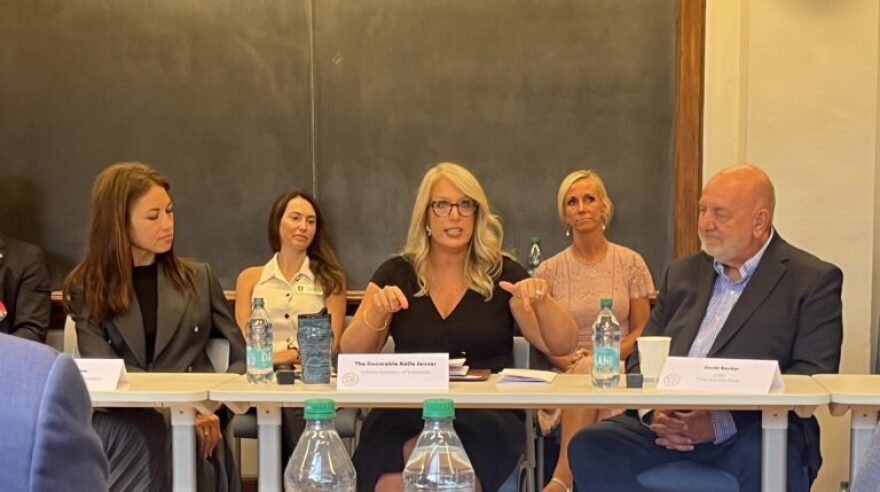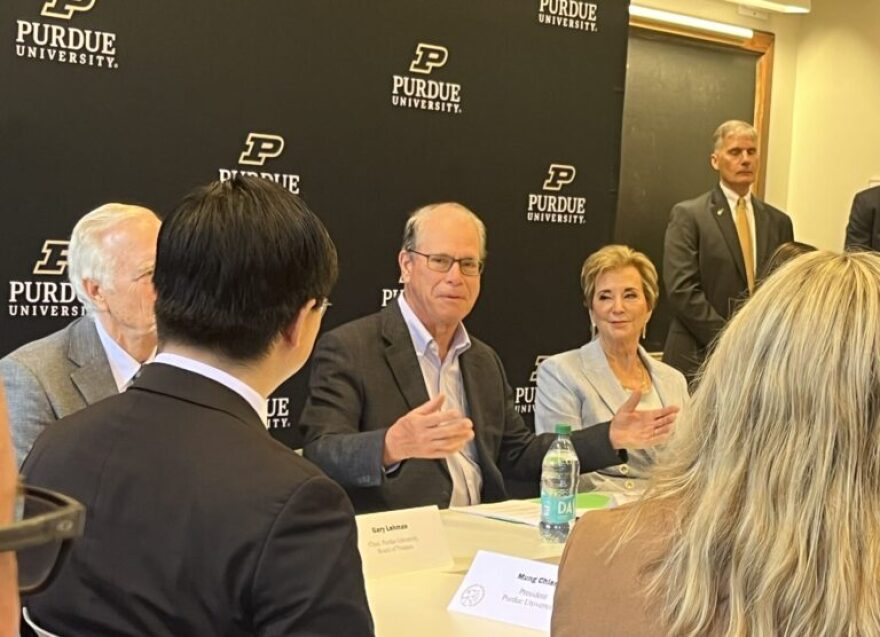Indiana Gov. Mike Braun welcomed U.S. Secretary of Education Linda McMahon to Purdue University on Wednesday, with the federal leader praising Indiana for its education initiatives that put “parents in the driver’s seat” for K-12 and higher education.
In particular, leaders celebrated a decade-plus of frozen tuition rates at Purdue and other initiatives as a “model for higher education” during President Donald Trump’s transformative second term.
“I’ve looked at all the things that are going on in Indiana and they really do match exactly what the President’s goals are,” said McMahon. “… He certainly believes more choice is what we ought to have, and I think Indiana has certainly proven that all those things work to the benefit of students in K-12 and higher education.”
McMahon declined to comment on an ongoing “review” of $6.8 billion in frozen federal funding earmarked for grade schools, including $107 million destined for Indiana schools. Likewise, she dismissed concerns about the loss of civil rights protections for minority or disabled students, pointing to other avenues for relief through the Department of Justice.
McMahon’s department, one of many with ongoing mass layoffs, is set to be dismantled under Trump, who previously said he wants McMahon “to put herself out of a job.” Wednesday’s visit comes amid a nationwide reckoning for higher education institutions, some of which are grappling with hundreds of millions of dollars in frozen funds and other Trump administration threats.
But McMahon called Purdue’s 14-year streak of frozen tuition rates “absolutely remarkable,” while Gov. Mike Braun said the university was “at the forefront of how higher education should be run.”

“You’re kind of the model for what higher education needs to be across the country, and now other public schools in our state have followed suit,” Braun said. “The legislature and I … we’ve put that out there as kind of our mantra: parents in the driver’s seat for their own kids’ education — from K-12 and then post secondary as well.”
McMahon and Braun sat in on a closed door roundtable discussion with over a dozen other state leaders, including bankers, philanthropists, school corporation superintendents and Republican legislative leaders.
“We’ve worked hard to build out a recipe for success,” said Indiana Education Secretary Katie Jenner. “I think we’re still at the starting point, and have more work to do.”
Jenner highlighted the state’s ongoing effort to overhaul its high school diploma and support more apprenticeship programs.
“We frequently get everyone in the room — early and often — and listen,” continued Jenner. “… (by) listening to each other, we’ve had a lot of conversation in education (on) how we might really listen more to business and industry leaders to really let us know what are the knowledge and skills we could really improve on.”
Parents driving higher education learning
Both McMahon and Braun emphasized the need for parents to lead on education issues, even when those young adults leave home and attend higher education institutions. But, when asked, Braun said it wasn’t coddling.
“Because that discussion about what you’re going to do for the rest of your life is going to be mostly the parents thinking about it before their kids are ready to,” Braun said. “The key thing is having options, so parents know what the best ideas are.
“Parents are going to be in the driver’s seat, because they’re generally going to pay the bills. They, along with their kids, formulate what’s best for them,” Braun continued.

Braun said that higher education — and health care, another core focus for his administration — didn’t innovate enough, which drove up costs. He highlighted the renewed focus on apprenticeships as an alternative.
And while McMahon lauded Indiana and Purdue’s focus on apprenticeships, she panned any mandated efforts at the federal level.
“The federal government will continue to provide the kind of funding that is already appropriated by Congress,” said McMahon. “… but what the president, what the federal government, wants to do is get out of the way and remove a lot of regulation. Let’s get more money into the states that’s now spent on bureaucracy. I think that’s what you’ll see.”
The workforce-focused visit comes on the heels of a 15% staff reduction at the Department of Workforce Development, which Braun described as an event “that would never be a criterion or a metric in the real world of running something.”
“It’s about how you get the most out of the resources you’ve got and, in many cases, you do it better,” Braun said, describing the state and other industries as “bloated with middle management.”
Rather, he said it was a reflection of state employment growing faster than the economy.
“Wait and see,” he said. “It’s very little workforce reduction (and) only to where it’s going to make that agency work better.”
Indiana Capital Chronicle is part of States Newsroom, a nonprofit news network supported by grants and a coalition of donors as a 501c(3) public charity. Indiana Capital Chronicle maintains editorial independence. Contact Editor Niki Kelly for questions: info@indianacapitalchronicle.com.


